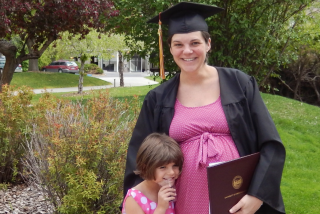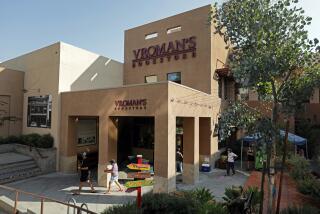Author Takes Upbeat View of East L.A. Institution
In 1968, Esteban Torres, a onetime worker at the Chrysler auto assembly plant in Commerce, joined with United Auto Workers President Walter Reuther and the federal government to form an organization dedicated to building the economy of East Los Angeles.
Torres, who rose from the factory floor to UAW leadership and eventually a seat in Congress, believed that East L.A. was “a colony dependent on outside forces”--Los Angeles’ Anglo power structure, which he viewed as disdaining East L.A.’s predominantly Latino residents.
The organization, which Torres headed, was initially called the East Los Angeles Labor Community Action Committee. It later changed its name to TELACU--the East Los Angeles Community Union.
Since its founding, TELACU has become a conglomerate with gross revenues approaching $100 million a year, its history filled with controversy, criticism and praise.
Now, a new book written by John R. Chavez, a history professor at Southern Methodist University in Dallas and a native of East L.A., takes a hard look at TELACU’s first 25 years. The book, published by Stanford University Press, is the first scholarly study of the organization.
TELACU is a nonprofit organization with for-profit subsidiaries designed to pump up local economies by starting local businesses with money from government and private sources.
Six such organizations were formed around the country as part of Washington’s effort in the 1960s to bring businesses and jobs to impoverished areas of urban America. In New York, the concept was used to address the appalling poverty in Bedford-Stuyvesant, Brooklyn, N.Y.’s largest black ghetto.
But controversy is part of TELACU’s legacy. A whistle-blower accused it of spending irregularities, prompting an investigation by federal auditors in 1982. The Times published a three-part series the same year that questioned TELACU’s spending.
Chavez’s book, “Eastside Landmark: A History of the East Los Angeles Community Union, 1968-93” describes TELACU as a landmark institution that has been largely misunderstood by its critics.
Chavez writes that it helped change the physical, educational and political landscape in East L.A. and other communities far beyond.
TELACU financed the construction of thousands of low-income housing units throughout Southern California, donated $3 million in scholarships to Latino students, started a thrift and loan that eventually became a bank and built the upscale Tamayo restaurant.
Hispanic Business magazine, which annually ranks the top 500 Latino-owned businesses in the country, listed TELACU as the 28th largest. In 1997, it was 31st.
Chavez says that its greatest accomplishment is its Eastside headquarters and adjacent industrial park, which he describes as a symbol of Mexican Americans’ desire for economic self-determination.
The industrial park on Goodrich Boulevard has an estimated 60 companies with 2,200 employees, ranging from small electronics firms to the corporate headquarters of the Aaron Bros. Art Marts. Another two dozen groups, mostly Latino, are housed inside TELACU’s three-story corporate building.
“I feel that TELACU is a worthy institution that has done far more good than ill,” Chavez said. “It has visibility and stability that other institutions on the outside [of East L.A.] have. Most Mexican American agencies don’t have that kind of presence.”
Chavez’s assessment is markedly different from the one that emerged as a result of the federal investigation.
Tracking the Money
A former employee charged that TELACU had violated provisions of a federal jobs program by allowing enrollees to work for Democratic candidates. Although he settled with the community union after he was fired, his accusations attracted federal auditors, who suspected that TELACU might have been guilty of other violations between 1976 and 1979.
After 2 1/2 years of scrutiny, the community union was forced to refund $1 million for mishandling a rural assistance program aimed at helping poor people. One TELACU official, board Chairman Joe L. Gonzalez, was placed on five years’ probation after he admitted that he enrolled in a federal jobs program and got paid thousands of dollars for work he never did.
Federal auditors believed that TELACU misspent $4.5 million. But the U.S. attorney in Los Angeles at the time, Stephen Trott, said TELACU was free to spend the federal funds any way it saw fit because the law gave such organizations wide latitude in expenditures.
Nevertheless, Los Angeles city and county officials canceled several contracts they had with TELACU.
The Times did an investigative series on TELACU’s alleged mismanagement, lavish spending by its executives and a lack of substantive projects in East L.A.. It painted the picture of a good idea gone haywire.
Chavez recounts these events and delves into TELACU’s involvement in the local Latino political scene.
He says TELACU has a penchant for playing the Eastside equivalent of Boss Tweed. He tells how it had a behind-the-scenes role in the 1982 Assembly race between Gloria Molina, a onetime TELACU employee, and Richard Polanco, then an executive with a TELACU think tank. TELACU opposed Molina, and the dissension between the two campaigns led to hard feelings that remain today.
The book examines the relationship between TELACU and Los Angeles City Councilman Richard Alatorre, a TELACU ally who often sides with Polanco. Alatorre has been accused of using his influence to steer public contracts to the community union.
Although it clearly favored Alatorre’s operation, Chavez says, TELACU’s assistance to Chicano officeholders from the Eastside hardly stopped there--including, for example, help for Torres, its former leader, who became an ally of Molina’s.
“Throughout the years, and most evidently in 1982, the community union in one way or another assisted virtually every Mexican American elected official in gaining the positions necessary to empower the Eastside,” Chavez writes.
He says most of TELACU’s problems stem from misunderstandings about what it actually is.
Although it grew out of President Lyndon Johnson’s War on Poverty, Chavez argues that it was never just an anti-poverty agency.
A Unique Amalgamation
TELACU was really something that defied definition--”a federally funded community development corporation, a quasi-public, semiprivate institution,” he writes. Such corporations were permitted to establish for-profit subsidiaries, businesses designed to provide local jobs, remove blight and contribute to charity by making profits for the “nonprofit” holding company.
The community union was the brainchild of UAW loyalists like Reuther, who believed that it could organize neighborhoods for a common goal and, in the process, gain more members for organized labor. But it was Torres who believed that a business component was necessary.
“To end colonialism--to recover self-determination--Torres and TELACU argued that economic development had to take place within minority communities, such as East L.A., for the benefit of their own residents,” Chavez writes. “Such development would establish the basis for general social recovery and genuine integration into the larger society.”
Chavez writes that to term TELACU simply an anti-poverty agency, as critics and reporters have often done, is incorrect and misleading. Such a label “makes it sound like it’s doing charity or welfare work,” he said.
TELACU came into existence when social unrest on the Eastside was widespread. Poverty, low academic performance in area schools and unemployment were commonplace. Residents had little power to address these concerns since East L.A. wasn’t even a city.
Torres, at that time a ranking UAW official, came home to East L.A. to become the community union’s first executive director. Among his first acts was to work for East L.A. cityhood. Without it, he reasoned, the unincorporated Eastside barrios would be forgotten.
Despite his leftist rhetoric of calling the community a “colony,” Torres disappointed Chicano radicals by steering a centrist course, pointedly accepting the verdict of East L.A. voters when they rejected cityhood in 1974.
The conflicting expectations for TELACU added to the misunderstandings about its purpose and goals. “Torres and TELACU,” Chavez writes, “had to reconcile the contrary visions that had led to its founding.”
Eventually, Torres left TELACU to pursue a political career. He initially took a job in President Jimmy Carter’s administration, but later returned to eventually win an Eastside seat in Congress, representing an area that stretched from East L.A. and Pico Rivera to Whittier and the San Gabriel Valley. In later years, as controversy dogged TELACU, Torres distanced himself from the organization.
Community Response
Reaction to the 264-page book has been surprisingly mild, especially from vociferous critics of TELACU.
Chicano Studies professor Rodolfo Acuna, who opposed the community union’s proposal to revitalize Olvera Street in the early 1990s, is mildly complimentary of the book.
“For all of the criticism from people such as myself, the reality is that TELACU is an American institution run by brown people,” said Acuna, a professor at Cal State Northridge. “Its success depends on playing the rules of capitalism and influence-peddling. . . . The gnawing reality is that TELACU would not be as successful if it had played by other than American rules, which at times includes a Taco Bell vision of development and the accumulation of political and economic hegemony.”
Another critic, Cal State Northridge professor Raul Ruiz, who as a member of La Raza Unida party ran for the City Council in the failed East L.A. incorporation election, said the community union would gain greater acceptance if it were more open about its dealings, which echoes a major criticism voiced by Chavez in the book.
“TELACU should be more forthright about its investments and its operations,” Ruiz said. “If it was open about what it’s all about, then maybe there would not be these questions that are asked about it.
“I think they’re big enough” to be more open.
Chavez says allowing stockholders to own a piece of TELACU would help dissipate the doubts. “Basically, it’s insufficiently connected to the local people” of the Eastside, he said.
David C. Lizarraga, who replaced Torres as TELACU’s chief executive officer, is pleased with the book but rejects Chavez’s suggestion of allowing more community input.
“The fact is, nonprofits are not owned,” he said. “They don’t have stockholders.”
During a telephone interview, Lizarraga said the book may prompt some to reevaluate their criticism of the community union.
“Maybe one day, they won’t use the word ‘controversial’ in talking about TELACU,” he said.
More to Read
Sign up for our Book Club newsletter
Get the latest news, events and more from the Los Angeles Times Book Club, and help us get L.A. reading and talking.
You may occasionally receive promotional content from the Los Angeles Times.






